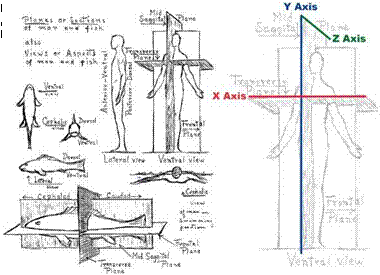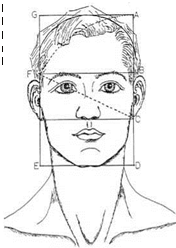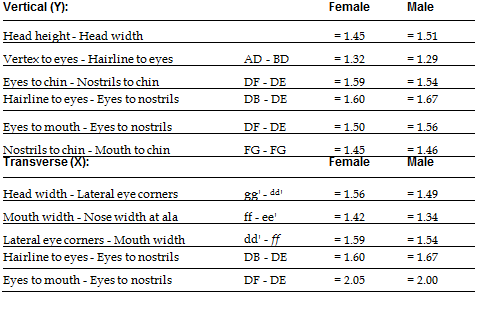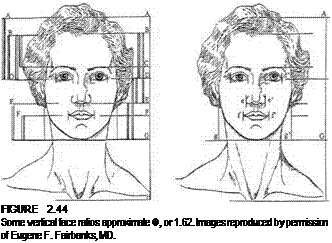Before we can discuss dynamic symmetry of the human body, we need to establish a visual frame of reference for when proportions are mentioned. Anatomical planes are crucial to describing human anatomy in a way that makes it readily understandable to others. Based on a vertical figure facing the observer, let’s compare planes based on a figure whose central axis is horizontal. This is like working in 3D, modeling in the X, Y, and Z axes, where X is side to side, Y is up and down, and Z is front to back.
Dynamic symmetry can be expressed in the Fibonacci series and in the Golden Rectangle. The Fibonacci series is a series of numbers in which any number of the series is the sum of the two previous numbers, such as a + b = c; b + c = d. It starts with 1; 1 + 1 = 2; 1 + 2 = 3; 2 + 3 = 5; 3 + 5 = 8; 5 + 8 = 13; 8 + 13 = 21; and so on. The
 |
 |
ratio of a number of a sum divided by the preceding number approximates 1.62…; 21 4 13 = 1.615; 13 + 8 = 1.625, and so on. This number is called Phi, or Ф.[26]
For example, the ratio of the height of a human male head to its width is approximately (on average) 9 inches to 5% inches; 9 4 5.25 = 1.61. Many proportions of the human body share this ratio.[27]
As already mentioned, representative proportions and average measurements will not be found in any one person; in creating a figure for a makeup effect or perhaps as a prop, it might be best to work with a live model for truly accurate representation. Nonetheless, Phi ratios are valid and can be used to create accurate and pleasing results:[28]
Few people are aware of the significance of Leonardo da Vinci’s The Vitruvian Man drawing and its relationship to human proportion. Quoting Vitruvius, a celebrated Roman architect under both Julius Caesar and Augustus Caesar, "Then again, in the human body, the central point is naturally the navel (umbilicus). For if a man be placed flat on his back with his hands and feet extended, and a pair of compasses centered at his navel, the fingers and toes of his two hands and feet will touch the circumference of a circle described therefrom. And just as the human body yields a


circular outline, so too a square figure may be found from it. For if we measure the distance from the soles of the feet to the top of the head and then apply that measure to the outstretched arms, the breadth will be found to be the same as the height as in the case of plane surfaces which are perfectly square."
Whatever motivates your makeup design, there is a natural law of symmetry you can follow and adapt to the universe where your character exists, but its design must still adhere to a set of symmetrical rules; it is also imperative that the design follow criteria set for the production, whether theater or film. Nature must give the base from which to build on a design, but since the makeup is to be theatrical and will be worn, that becomes the paramount design parameter to keep in sharp focus.
Through anthropometry, the study of the measurement of humans, ratios of other body proportions have been determined, all of which can be extremely beneficial in creating special makeup effects.
